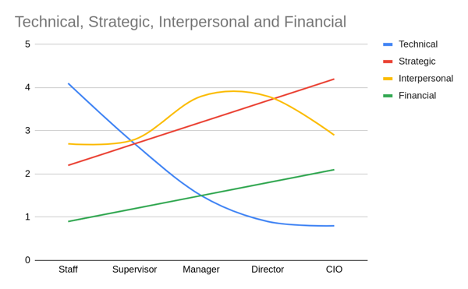 The four qualities of IT leaders
The four qualities of IT leaders
Everyone in an organization needs to find balance between Technical, Interpersonal, Strategic, Financial. IT leaders need to choose their focus.
There’s a classic saying in leadership that “What got you here won’t get you there.” It’s a reminder that what’s important to your job changes as you move into new responsibilities and that you will need to refocus your priorities to achieve continued success.
The four qualities
A few years ago, I surveyed IT leaders, managers, and staff with a series of questions about the work they do, focused on where they fit in their organization and the relative importance of four qualities: Technical, Interpersonal, Strategic, Financial.
- Technical – The tasks that are very hands-on by nature, often managing servers or databases, or supporting other systems or desktop environments.
- Interpersonal – Building relationships, the give and take of interacting with others.
- Strategic – Time spent thinking about the overall IT organization, and how the organization needs to respond to meet new challenges.
- Financial – Factoring in costs, either at the small scale (tools, etc.) or at the larger scales (budgets, etc.)
Note that these aren’t “skills” per se, but they are qualities that are important to the work performed within each role. You might consider the Relative Importance to indicate the contribution of each quality to the role’s function in the IT organization.
Relative importance
The survey was not a simple 1-2-3-4 ranking exercise; the survey asked respondents to rank the importance of each quality relative to the others on a zero to ten scale with the total of all four qualities equal to ten.
At first, this may seem like an odd way to ask folks to rate the importance of qualities, but that’s because we’re too used to ranking items on an independent “1” to “5” Likert scale. A Likert scale is a scale commonly used in questionnaires and most widely used in survey research. A Likert scale asks respondents to rank each quality independently of one another. But I was more interested in how people balanced each quality with the others.
Respondents represented higher education, government, nonprofit, and corporate sectors, although most of the responses were from higher education. The results show several aspects of leadership at different levels in an IT organization, and the relative importance of the four qualities.

There are several interesting things to note about leadership based on these results. I find three key themes from the results:
1. The vanishing value of Technical
Not surprisingly, the relative importance of Technical drops very quickly at higher levels in the IT organization. For a Chief Information Officer, the importance of Technical is quite low. That doesn’t indicate that a CIO lacks technology skills, such as setting up a Linux server, or editing web pages. But this is not what a CIO typically does in his or her role, so the Technical quality is not very important compared to the other qualities at the higher levels of IT leadership.
This is an important trend in understanding how to communicate with those around you and how to frame a position. You may have experienced this if you ever tried to convince your director or CIO to adopt a new path in technology. You can’t make a compelling case based simply on technical merit. Rather, your case will be better received if you focus on how your idea will benefit the organization (Strategic) or will help others to be more effective (Interpersonal).
Overall, the quickly falling Technical indicates that IT leaders are finding ways to balance “Leader,” “Manager,” and “Staff.” This is an important balance for anyone in IT. With “Leader/Manager/Staff,” you can pick up to two. For example, you can be a leader and manager which is typical of what we consider to be the job of most IT leaders who need to see the future, but also manage their own teams. Or you can be a leader and staff, such as an architect in an organization who needs to set technology direction while also contributing to code libraries. Or you can be a manager and staff, what most people would call a working manager or a team lead who manages a small team, but also contributes to the work. But the reality is that you cannot effectively navigate all three at the same time. And this survey suggests that as folks rise in the IT organization, they are appropriately giving up the “Staff” tasks so they can focus on “Leader/Manager.”
2. The balancing act of the team lead
Note what happens at the supervisor or team lead level. Three of the four qualities have equal relative importance. Technical, Strategic, and Interpersonal are equally weighted for the team lead. This balance may be a strength at that level in the organization but will prove to be a difficulty in reaching for the next level in an organization. Successful team leads will have learned to balance their attention across Technical, Strategic and Interpersonal. They have the necessary technical background to address IT issues with their teams, but have started to develop a more strategic view of the organization. Successful team leads have learned to form interpersonal relationships with those above and below, often acting as a kind of interpreter or interface between the two levels.
However, conventional wisdom for new managers states that “what got you here won’t get you there.” Rising through the ranks of an IT organization, Technical plays a key role at the staff and team lead level. In most IT organizations, staff become team lead and manager through demonstrating their proficiency in technical systems. The reward for good work can be more work, and eventually a bump up to the next level.
Until you reach team lead, anyway. In that role, your technical background becomes less important to reaching the next level. To take the next step to manager requires putting aside more of your technical background and focusing more on the larger issues. When you’ve spent so much time and energy balancing the demands of Technical, Strategic, and Interpersonal, it is awfully hard to finally let go of Technical so you can focus your attention on new strategic thinking.
3. The drop in Interpersonal at the CIO level
The trends all seem to follow a predictable progression. The importance of technical falls while the value of Strategic and Interpersonal rises; these changes are not very surprising. At the CIO level however, things change. While the other trends continue, the importance of Interpersonal drops sharply. This is different from the previous survey, where Interpersonal had a sudden but small uptick at the CIO level.
One reason CIOs do not value interpersonal relationships as much as the directors below them might be that CIOs perceive greater latitude in making decisions at the top of their IT organization. Thus, they might assume interpersonal relationships to be less important. Meanwhile, the director still needs to carry a favorable relationship with the CIO, to get buy-in on new initiatives—and with the managers below them, to make projects run more smoothly.
Overall, consider the balance of skills at different leadership levels in the organization, from staff to CIO. Where you may place importance on a set of skills at your level, others may strike a different balance. This is especially important as you consider moving up to the next level in the organization. The skills that you value today may not remain as important if you change roles. From staff to team lead, from director to CIO, the relative importance of Technical, Strategic, Financial, and Interpersonal will shift. Be prepared to let go of certain skills, and gain new ones.
